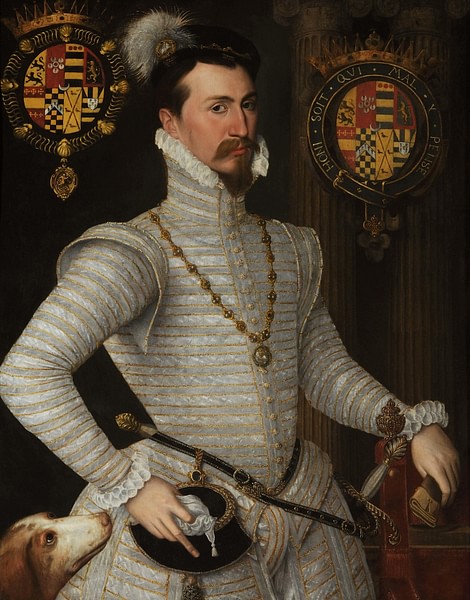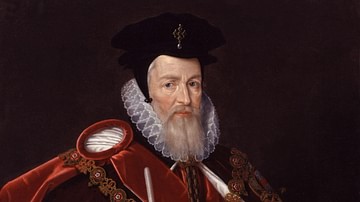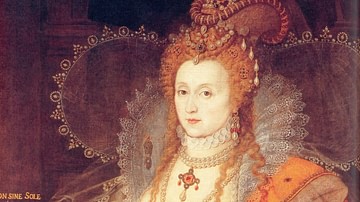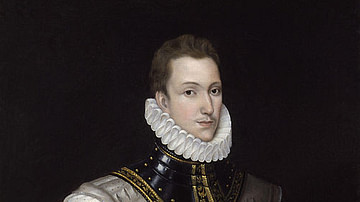
Robert Dudley, 1st Earl of Leicester (l. c. 1532-1588), was a high-ranking courtier who rose to become a favourite of Elizabeth I of England (r. 1558-1603). Rumours abounded that Dudley sought to marry the queen, and their relationship may well have gone beyond that of monarch and minister. Holding all manner of titles and estates, Dudley pushed for a more aggressive approach to foreign policy but came unstuck in two failed expeditions to help rebel Protestants in the Netherlands between 1585 and 1587. Dashing and entertaining, the Earl of Leicester accompanied the queen on many of her annual tours around England and maintained a special place in her affections until his death in September 1588.
Early Life
Robert Dudley was born c. 1532, the son of John Dudley, the Duke of Northumberland. The duke had been executed by Mary I of England (r. 1553-1558) for not supporting her succession. Robert had himself been accused of being involved in the plot to have Lady Jane Grey succeed Edward VI of England (r. 1547-1553), which indeed he had been. Robert was sent by his father to capture Mary during the coup but the soon-to-be queen had by then already fled to East Anglia. Dudley was imprisoned in the Tower of London and even sentenced to death but he was later pardoned by Mary. This was third time lucky for the Dudleys as Robert's grandfather, like his father, had been executed for treason in 1510. Despite his compromising family history and disastrous career start, the handsome and ambitious Robert Dudley would rise to the very pinnacle of English politics.
In 1550 Dudley married Amy Robsart, a decision he perhaps regretted later in life. Dudley and Princess Elizabeth, Mary's half-sister, were friends before the former became queen in 1558. In 1557 Dudley fought with distinction against the French at the Battle of Saint-Quentin. In 1559, after Elizabeth became queen, Dudley was appointed Master of the Horse, a highly honoured position that put him in charge of his monarch's stables, transport, and hunting hounds. Another honour was to be made a member of the distinguished Order of the Garter, a relic of medieval chivalry which continues today.
Suitor to the Queen
From around 1560, there were rumours that the relationship between Elizabeth and Dudley went beyond mere friendship. There were many other suitors at home and abroad who competed for Elizabeth's hand but Dudley had apartments next to the queen's in most of her major residences. Countering this view of the relationship was the fact that Dudley was married, but even here the rumour-mongers found fuel for their suspicions. Dudley's wife was found dead on 8 September 1560 lying at the bottom of a flight of stairs with her neck broken. Some said it was a tragic accident - and she had been ill with cancer for some time - while others speculated that she had been pushed by a husband eager to free himself for his queen. An incriminating fact was that the household servants had been sent away prior to the 'accident'.

Promotions & Earldom
Despite the scandal and the rumours of what went on between them, the queen and Dudley remained good friends. In October 1562 Dudley was made a member of the Privy Council, and at only 30 years of age, an unusually young one. Elizabeth may have used the impetuous and radical-thinking Dudley as a counterbalance to the other powerful player in English politics, the conservative William Cecil, Lord Burghley (1520-1598). This rivalry was not only one of ideas but also one of courtier and statesman. In 1564 Dudley refused Elizabeth's offer to have him marry her cousin, Mary, Queen of Scots (r. 1542-1567). Dudley, knowing his queen well, gave his excuse that he could not bear to be parted so far from his sovereign.
Elizabeth next made Dudley an earl on 28 September 1564, creating the new earldom of Leicester for him and even throwing in the title of Baron Denbeigh. It was unusual to grant an earldom to a man who was not directly related to the monarch and so the move shows the high esteem Dudley enjoyed in the queen's eyes. Dudley received his new title and estates in a lavish ceremony at St. James' Palace. The next year, Dudley was given two ex-monasteries in Yorkshire, a house in Kew and, best of all, Kenilworth Castle in Warwickshire where he royally entertained his queen on many occasions (see below). The earl would add a magnificent new gatehouse to his new home. At entertainments elsewhere, Dudley often acted as the queen's host. It was clear to all, then, that this man was, without doubt, the queen's favourite.

Another threat to the friendship was jealousy from the queen when Dudley was involved with other women. Nevertheless, the continued intimacy between Elizabeth and Dudley is illustrated by the following observations made by Sir James Melville, an ambassador to the court visiting in 1564:
She [Elizabeth] took me into her bed-chamber, and opened a little cabinet, wherein she kept many little pictures wrapped within paper, and their names written on with her own hand upon the papers. Upon the first that she took up was written, 'My Lord's Picture'. I held the candle and pressed to see which picture was so named. She appeared loath to let me see it; yet I prevailed for a sight of it, and I found it to be the Earl of Leicester's picture.
(Ferriby, 183)
Dudley's accumulation of titles and estates continued. In 1563 he was appointed high steward of Cambridge University and several towns, and in 1564, he became chancellor of Oxford University. The earl's tentacles of power at local level extended everywhere from holding positions as Justice of the Peace in several counties to acting as the high recorder of Maldon in 1565. These were common enough positions for a high-ranked courtier to hold but Dudley impressed with the sheer number and geographical scale of his appointments.

Expeditions to the Netherlands
Even though the queen moved on to other favourites, she was angry when she discovered Dudley had married in secret - to Lettice Knollys, the countess of Essex - in 1578. Dudley was banished from the court but returned again when the queen regained her composure. In 1585 Dudley was selected to lead an expeditionary force of 7,000 men to aid rebels in the Netherlands against the rule of Philip II of Spain (r. 1556-1598); Elizabeth had finally given in to demands to more actively help Protestants in Europe.
The expedition was a failure because the force sent was too small and too badly equipped, and Dudley, entirely due to his own mismanagement, was left without sufficient funds to pay his professional soldiers. In addition, the Earl of Leicester had no experience at field command, and it showed when he upset his own commanders and his allies. Dudley then went one step further and upset his monarch by accepting the title of Governor of the Netherlands, bestowed on him by Protestants hoping to permanently tie England's foreign policy to their own struggle for independence. Consequently, Elizabeth called home the earl in November 1586. The next year, though, Dudley was back in the Netherlands as Elizabeth was obliged to meet her treaty obligations with the Dutch. There was even less success than his first stint there, as Dudley managed to lose control of Sluys to Philip II's regent, the Duke of Parma. Once again, after upsetting everyone on all sides, the earl resigned and was called home by his sovereign in November 1587.
Patching up their friendship again, Dudley was to have led the queen's land army stationed at Tilbury to face the Spanish Armada in August 1588 but he was too unwell to do so and died in September. Dudley's obituary, written by the famed poet Edmund Spenser (c. 1552-1599), ran as follows:
He now is dead, and all his glory gone,
And all his greatness vapoured to nought,
That as a glass upon the water shone,
Which vanished quite, so soon as it was sought.
(Guy, 338)





